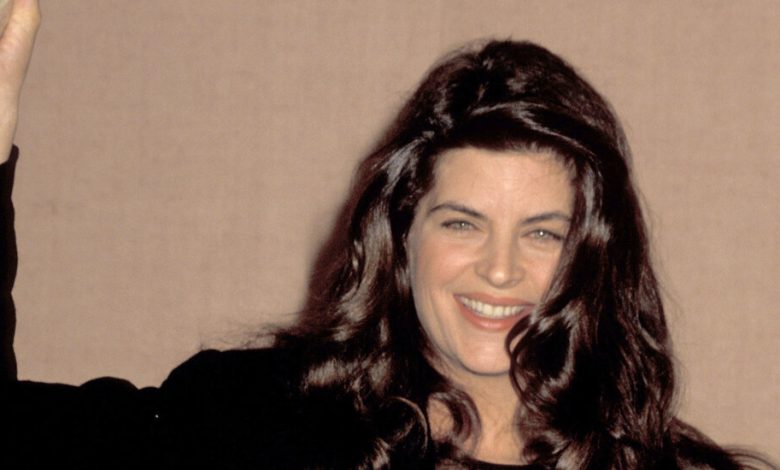Kirstie Alley’s Dance With Hollywood

Kirstie Alley, who died this week, was a knockout beauty with real comedy chops — qualities often assumed (wrongly) to be incompatible — whose self-ironic humor softened the “kapow” of her glamour-girl looks.
Whether playing a fictional character (as in “Cheers”), playing herself (in interviews or in her reality TV series, “Kirstie Alley’s Big Life”) or some version in-between (like the fictionalized version on “Fat Actress”), Ms. Alley infused every performance with a sly self-awareness. “I know I’m gorgeous,” she seemed to say, “but I don’t take myself too seriously and you need not either.”
Ms. Alley was a rare standout in Hollywood for being a full-figured, at times even self-proclaimed, “fat actress,” who never stopped being sexy. Everything about her telegraphed lushness, abundance. She wore her dark hair in cascading waves that fell, à la Veronica Lake, over one eye. She was buxom. Her catlike eyes were framed by permanently arched brows that gave her a slightly ferocious look.
Ms. Alley felt visually anachronistic, like a throwback to the era of brunette sirens like Sophia Loren and Elizabeth Taylor (which made her early star turn on “Cheers,” replacing Shelley Long — model-thin and blond — all the more dramatic).
Beneath both the gorgeous and the funny, though, a strain of melancholy increasingly crept into Ms. Alley’s persona, and yes, it was about the weight. For while she seemed never to lose her sex appeal, and starred in a string of sitcoms and movies, her struggle with weight was inextricable from her public persona. Tabloids dogged her, punitively chronicling her body fluctuations: “TV bosses tell Kirstie Alley, ‘You’re too fat!’” screamed a typical headline of The National Enquirer in 2007. “She admits to gaining 30 pounds, but it’s really 50!” screeched another in 2014.
Ms. Alley responded gamely, making weight an overt part of her career. Rather than hiding, or disappearing to some spa to re-emerge mysteriously svelte, she owned the issue. She starred in her own sitcom, “Fat Actress,” documenting her character’s (and hence her own) journey to fitness.
“Honestly, I didn’t know how fat I was,” Ms. Alley said in a 2004 appearance with Oprah Winfrey (who had of course documented her own similar struggles), explaining that all the media scrutiny of her weight had led her to sign on as a spokeswoman for the Jenny Craig diet program. Two years later, Ms. Alley, then 55, returned to Ms. Winfrey’s show to show off her 75-pound weight loss, sashaying onstage in a bikini, layered over a nude body stocking. Ms. Winfrey and the audience cooed in amazement.
But the moment seemed more poignantly vulnerable than triumphant. Ms. Alley proclaimed she’d given up her habit of “eating with wild abandon.” She told People that, just before joining Jenny Craig, she’d asked herself, “I’m old. I’m fat. What am I worth?”
In other words, Ms. Alley’s public weight loss had become a redemption narrative, a story of sins atoned for, excesses restrained. That skintight body stocking layered under her bikini said it all: Her flesh would be displayed for scrutiny and subjected to all necessary restraints and compression in order to achieve the correct silhouette. Maintaining control of her weight would prove a never-ending battle.
Like millions of others, Ms. Alley gained back all the lost pounds, and then some. In 2011, she joined another television show — “Dancing With the Stars” — which again wound up training a spotlight on her “weight loss journey.” There’s nothing like rigorous dancing to lose weight, but Ms. Alley had some ballroom talent: She and her partner Maksim Chmerkovskiy earned second place in the competition.
Yet media coverage of Ms. Alley’s participation in the show focused on her body and dietary habits, often with numerical precision. She was interviewed about her exact calorie intake during the weeks of rehearsals for the show: Was 2,000 better than 1,400 for maintaining stamina? Ms. Alley herself used specific numbers to boast of how quickly she shrank dress sizes during the show’s run: “I started out a 12, then an 8, and then I think next week I’ll be a 6!” she told US Weekly.
Ms. Alley would drop 100 pounds that year — a statistic that was repeated endlessly, accompanied always by the inevitable before-and-after photos, along with reminders of her age, 60 at that time. Numbers everywhere. And once again, Ms. Alley spoke of having been estranged from her body before this weight loss: “I feel I’m back in my element. I honestly didn’t realize what I looked like,” she told “Entertainment Tonight.”
As recently as October of this year, a profile of Ms. Alley noted that she “has always followed certain methods to shed a lot of kilos, and at present, she not only looks slimmer and stunning but a lot younger than her age too.” (It’s true that Ms. Alley looked remarkably vibrant at 71, with no obvious artificial alterations to her face.)
So, was Ms. Alley complicit in her own objectification? Of course. Over and over, she agreed to divulge details of her diet, her calorie count, her exact weight. But she was coping, with humor and panache, with an antiquated system not of her own invention, a system she’d entered decades before anyone had heard of the body positivity movement.
And in this she was a pioneer, even if she couldn’t totally rid herself of the shame that still attends the subject of weight for women, and a culture that constantly assays and assesses us. If she kept retelling a circular story of her so-called falls from grace, she’s not alone there either — America has a special fondness for redemption stories (our politicians tell them constantly). Let’s remember and appreciate Kirstie Alley for the wry, sexy humor she infused those stories with, and her role at the very beginning of a movement for body acceptance, even if she never got to enjoy it.